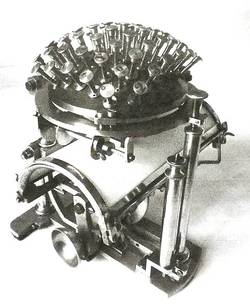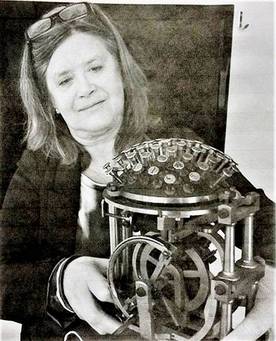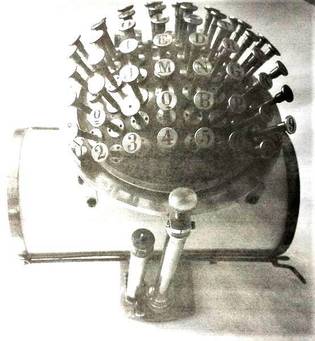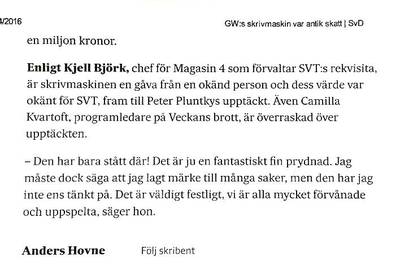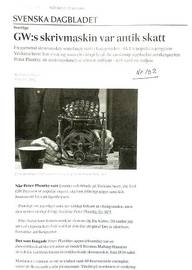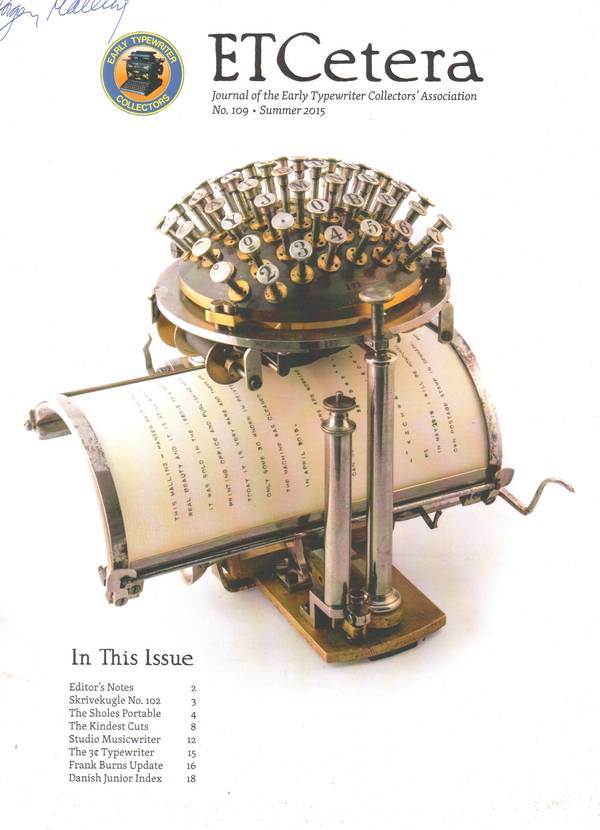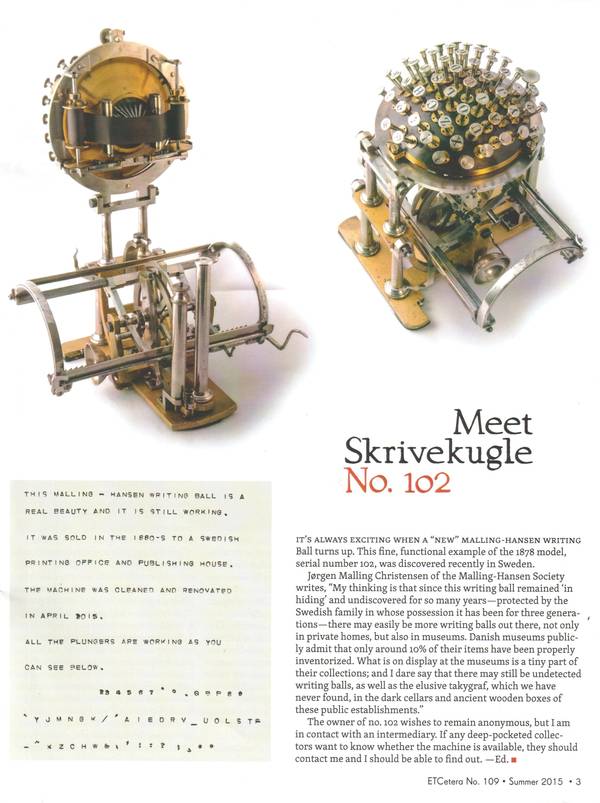A True Fairy Tale about Writing Ball number 102.
By Jørgen Malling Christensen.
We are all aware that not many writing balls were produced, and that even fewer are in existence today. However, a recent find in Stockholm, Sweden, shows that it is still possible to find specimen of the writing ball, which have been hitherto unknown or hidden away. This is the true story of writing ball number 102!
In January or February 2015 Swedish Television showed a programme in their long-running series called “crime of the week” (in Swedish: “Veckans brott”) in which experienced specialists discuss crimes committed in Sweden long time ago, where the police have never found the guilty party. In order to create a suitable sherlockian atmosphere, the producers had set up a studio with various props. One of these props was a machine the producers had come across on one of the myriad shelves of the huge storage building used by the Swedish Television. The producers found the gadget to be suitably arcane and brought it to the studio where it was placed unobtrusively on a shelf.
One of the viewers of the programme that evening was the well-known Swedish antique specialist Peter Pluntky. He has been an appraiser in the antique world for many years. As he was watching the programme he suddenly noticed that the prop on the shelf was, unmistakingly, a Malling-Hansen writing ball. He immediately phoned the TV-producers and alerted them to the fact that they were using a very rare and precious artefact as a prop. The Swedish TV had no idea what it was and had certainly no notion of its value.
Eventually, Peter Pluntky had the opportunity to see the writing ball, and to his joy and surprise found that this specimen – number 102 – was in very good condition, and after a few minor restorative efforts by him was returned to the owner. It can still type!
The excellent condition of this writing ball is evident from the photos; it appears that this is a portable writing ball with ribbon, - the lightweight and very elegant model from around 1876.
SA: It has to be said that the first Writing Ball with color ribbon was manufactured in 1878, in time for the World Exhibition in Paris 1878. From 1875 until 1878 the Writing Balls used a carbon paper and was not equipped with a color ribbon.
Writing Ball no. 102.
Research, transcription and comments by Jørgen Malling Christensen.
We have already documented this beautiful writing ball, model of 1878, which was discovered in Stockholm in January or February 2015 under spectacular circumstances. It was in surprisingly good condition, and after some limited restorative efforts by Peter Pluntky it was in good working condition, as you can see from the wonderful illustrations in the article. The writing ball was sold in auction in May 2019 at around 111,000 US dollars.
This extraordinary find was featured by the magazine ETCetera, Journal of the Early Typewriter Collectors’ Association in their issue no 109, summer 2015.
Below is the frontpage of the magazine and the article itself:
- - - - -
Meet Skrivekugle No. 102.
IT’S ALWAYS EXCITING WHEN A “NEW” MALLING-HANSEN WRITING Ball turns up. This fine, functional example of the 1878 model, serial number 102, was discovered recently in Sweden.
Jørgen Malling Christensen of the Malling-Hansen Society writes, “My thinking is that since this writing ball remained ‘in hiding’ and undiscovered for so many years – protected by the Swedish family in whose possession it has been for three generations – there may easily be more writing ball out there, not only in private homes, but also in museums. Danish museums publicly admit that only around 10% of their items have been properly inventorized[1]. What is at display at the museums is a tiny part of their collections; and I dare say that there may still be undetected writing ball, as well as the elusive takygraf, which we have never found, in the dark cellars and ancient wooden boxes of these public establishments.”
The owner of no. 102 wishes to remain anonymous, but I am in contact with an intermediary. If any deep-pocketed collectors want to know whether the machine is available, they should contact me and I should be able to
[1] JMC: Since 2015 this has probably changed markedly, because Danish museums have undergone a process of stock-taking as well as digitizing their items, making their collections partially or totally available to the public by internet.

